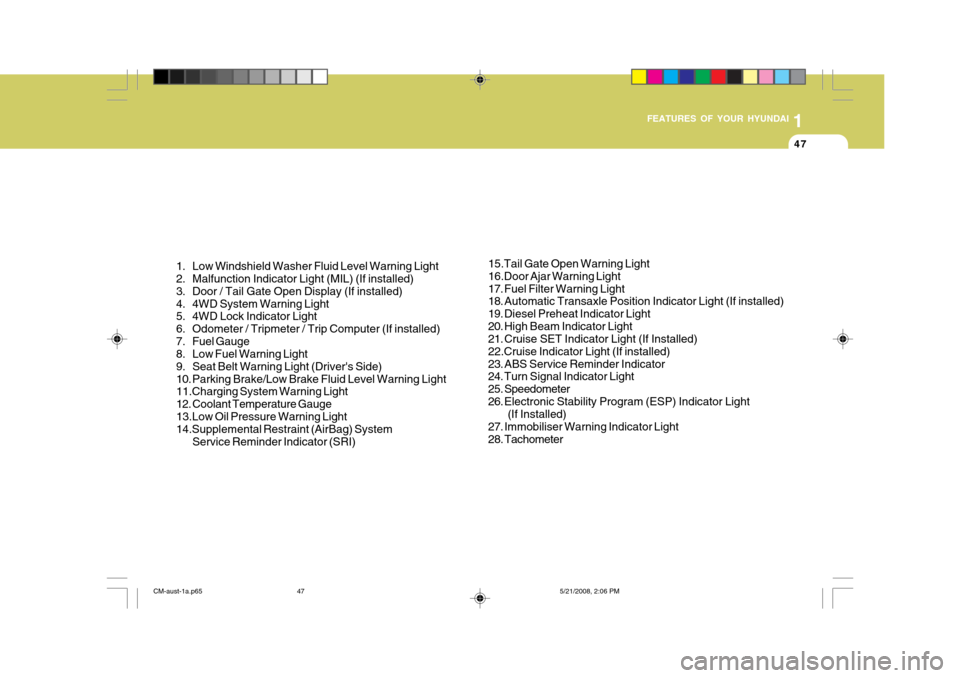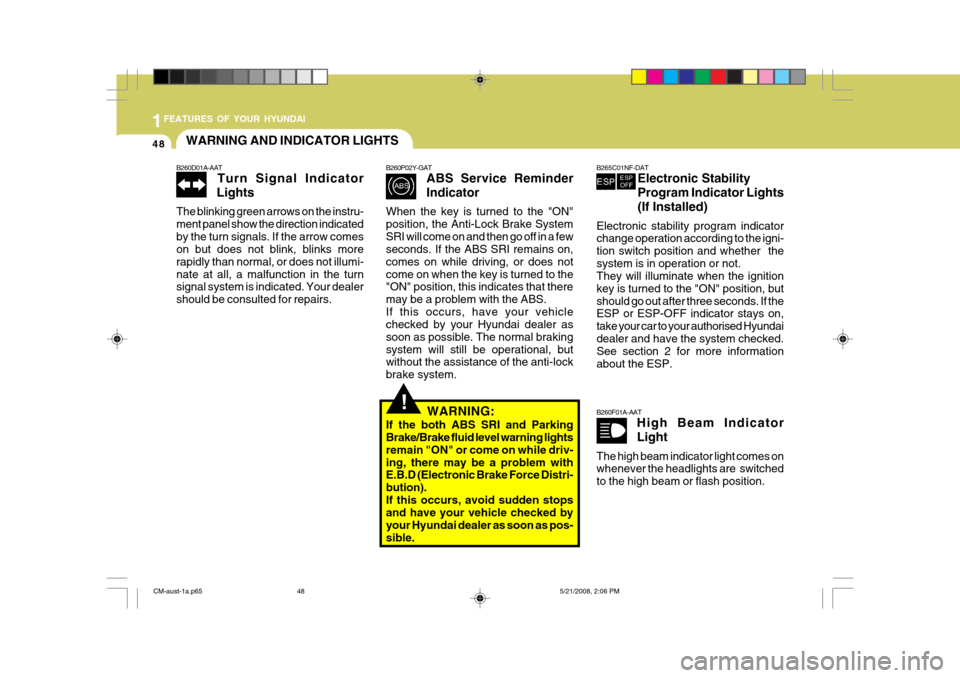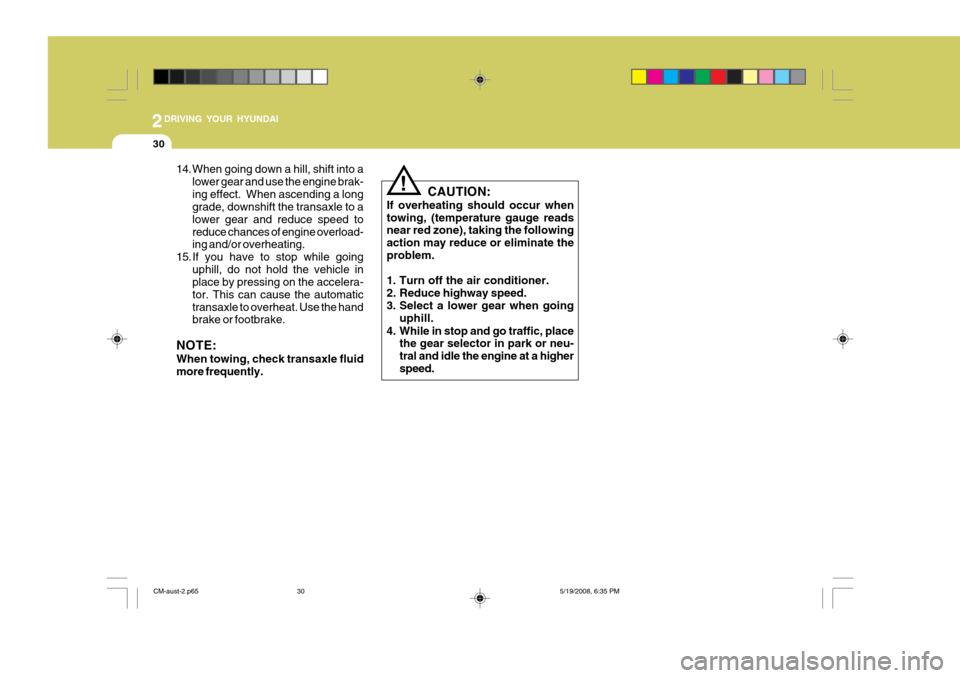2009 Hyundai Santa Fe brake fluid
[x] Cancel search: brake fluidPage 10 of 269

YOUR VEHICLE AT A GLANCE
F10B255A01CM-DAT INDICATOR SYMBOLS ON THE INSTRUMENT CLUSTER
* More detailed explanations of these items will be found beginning on page 1-48.
4WD System Warning Light
Malfunction Indicator Light
SRS (Airbag) Service Reminder Indicator (SRI)
Tail Gate Open Warning Light
Low Fuel Level Warning Light Door Ajar Warning Light
ABS Service Reminder Indicator
Turn Signal Indicator Lights
High Beam Indicator Light Low Oil Pressure Warning Light Parking Brake/Brake Fluid Level Warning Light Charging System Warning Light
Immobiliser Warning Light
4WD Lock Indicator Light
Electronic Stability Program Indicator Lights (If Installed)
Cruise SET Indicator Light (If Installed)
Door/Tail Gate Open Display (If installed)
Cruise Indicator Light (If Installed)
Low Windshield Washer Fluid Level Warning LightSeat Belt Warning Light
Diesel Preheat Indicator Light
Fuel Filter Warning Light (Diesel Engine)
CM-aust-00.p65 5/19/2008, 6:25 PM
10
Page 56 of 269

1
FEATURES OF YOUR HYUNDAI
45
1. Low Windshield Washer Fluid Level Warning Light
2. Malfunction Indicator Light (MIL)
3. Door/Tail Gate Open Display (If installed)
4. 4WD System Warning Light
5. 4WD Lock Indicator Light
6. Odometer / Tripmeter / Trip Computer (If installed)
7. Fuel Gauge
8. Low Fuel Warning Light
9. Seat Belt Warning Light (Driver's Side)
10. Parking Brake/Low Brake Fluid Level Warning Light 11.Charging System Warning Light
12. Coolant Temperature Gauge 13.Low Oil Pressure Warning Light 14.Supplemental Restraint (AirBag) System Service Reminder Indicator (SRI) 15.Tail Gate Open Warning Light 16.Door Ajar Warning Light
17. Automatic Transaxle Position Indicator Light (If installed)
18. High Beam Indicator Light
19. Cruise SET Indicator Light (If Installed) 20.Cruise Indicator Light (If installed)
21. ABS Service Reminder Indicator
22. Turn Signal Indicator Light
23. Speedometer
24. Electronic Stability Program (ESP) Indicator Light
(If Installed)
25. Immobiliser Warning Light
26. Tachometer
CM-aust-1a.p65 5/21/2008, 2:06 PM
45
Page 58 of 269

1
FEATURES OF YOUR HYUNDAI
47
1. Low Windshield Washer Fluid Level Warning Light
2. Malfunction Indicator Light (MIL) (If installed)
3. Door / Tail Gate Open Display (If installed)
4. 4WD System Warning Light
5. 4WD Lock Indicator Light
6. Odometer / Tripmeter / Trip Computer (If installed)
7. Fuel Gauge
8. Low Fuel Warning Light
9. Seat Belt Warning Light (Driver's Side)
10. Parking Brake/Low Brake Fluid Level Warning Light 11.Charging System Warning Light
12. Coolant Temperature Gauge13.Low Oil Pressure Warning Light 14.Supplemental Restraint (AirBag) System Service Reminder Indicator (SRI) 15.Tail Gate Open Warning Light 16.Door Ajar Warning Light
17. Fuel Filter Warning Light
18. Automatic Transaxle Position Indicator Light (If installed)
19. Diesel Preheat Indicator Light
20. High Beam Indicator Light
21. Cruise SET Indicator Light (If Installed) 22.Cruise Indicator Light (If installed)
23. ABS Service Reminder Indicator
24. Turn Signal Indicator Light
25. Speedometer
26. Electronic Stability Program (ESP) Indicator Light
(If Installed)
27. Immobiliser Warning Indicator Light
28. Tachometer
CM-aust-1a.p65 5/21/2008, 2:06 PM
47
Page 59 of 269

1FEATURES OF YOUR HYUNDAI
48
B260D01A-AAT
Turn Signal Indicator
Lights
The blinking green arrows on the instru- ment panel show the direction indicatedby the turn signals. If the arrow comes on but does not blink, blinks more rapidly than normal, or does not illumi-nate at all, a malfunction in the turn signal system is indicated. Your dealer should be consulted for repairs. WARNING AND INDICATOR LIGHTS
B260F01A-AAT
High Beam Indicator Light
The high beam indicator light comes on whenever the headlights are switched to the high beam or flash position.!
B260P02Y-GAT ABS Service Reminder Indicator
When the key is turned to the "ON" position, the Anti-Lock Brake SystemSRI will come on and then go off in a few seconds. If the ABS SRI remains on, comes on while driving, or does notcome on when the key is turned to the "ON" position, this indicates that there may be a problem with the ABS.If this occurs, have your vehicle checked by your Hyundai dealer as soon as possible. The normal brakingsystem will still be operational, but without the assistance of the anti-lock brake system.
WARNING:
If the both ABS SRI and Parking Brake/Brake fluid level warning lights remain "ON" or come on while driv-ing, there may be a problem with E.B.D (Electronic Brake Force Distri- bution).If this occurs, avoid sudden stops and have your vehicle checked by your Hyundai dealer as soon as pos-sible.
B265C01NF-DAT Electronic Stability Program Indicator Lights(If Installed)
Electronic stability program indicator change operation according to the igni- tion switch position and whether thesystem is in operation or not. They will illuminate when the ignition key is turned to the "ON" position, butshould go out after three seconds. If the ESP or ESP-OFF indicator stays on, take your car to your authorised Hyundaidealer and have the system checked. See section 2 for more information about the ESP.
CM-aust-1a.p65 5/21/2008, 2:06 PM
48
Page 60 of 269

1
FEATURES OF YOUR HYUNDAI
49
!
B260G01A-AAT
Low Oil Pressure Warn- ing Light
CAUTION:
If the low oil pressure warning light stays on while the engine is running,serious engine damage may result. The oil pressure warning light comes on whenever there is insufficient oilpressure. In normal operation, it should come on when the ignition switch is turned on, then go outwhen the engine is started. If the oil pressure warning light stays on while the engine is running, there is aserious malfunction. If this happens, stop the car as soon as it is safe to do so, turn off theengine and check the oil level. If the oil level is low, fill the engine oil to the proper level and start the engineagain. If the light stays on with the engine running, turn the engine off immediately. In any instance wherethe oil light stays on when the engine is running, the engine should be checked by a Hyundai dealer beforethe car is driven again.
!
B260H02A-GAT Parking Brake/Low Brake Fluid Level Warning Light
WARNING:
If you suspect brake trouble, have your brakes checked by a Hyundai dealer as soon as possible. Driving your car with a problem in either thebrake electrical system or brake hy- draulic system is dangerous, and could result in a serious injury or death.
Warning Light Operation The parking brake/low brake fluid level warning light should come on when theparking brake is applied and the ignition switch is turned to "ON" or "START". After the engine is started, the lightshould go out when the parking brake is released. If the parking brake is not applied, the warning light should comeon when the ignition switch is turned to "ON" or "START", then go out when the engine starts. If the light comes on atany other time, you should slow the vehicle and bring it to a complete stop in a safe location off the roadway. The brake fluid level warning light indi-cates that the brake fluid level in thebrake master cylinder is low and hy- draulic brake fluid conforming to DOT 3 or DOT 4 specifications should be added.After adding fluid, if no other trouble is found, the car should be immediately and carefully driven to a Hyundai dealerfor inspection. If further trouble is expe- rienced, the vehicle should not be driven at all but taken to a dealer by aprofessional towing service or some other safe method. Your Hyundai is equipped with dual-diagonal braking systems. This means you still have braking on two wheels even if one of the dual systems shouldfail. With only one of the dual systems working, more than normal pedal travel and greater pedal pressure are requiredto stop the car. Also, the car will not stop in as short a distance with only half of the brake system working. If thebrakes fail while you are driving, shift to a lower gear for additional engine brak- ing and stop the car as soon as it is safeto do so.
CM-aust-1a.p65
5/21/2008, 2:06 PM
49
Page 157 of 269

2DRIVING YOUR HYUNDAI
12
C090H01L-GAT NOTE:
o For smooth and safe operation,depress the brake pedal when shifting from "Neutral" position or "Park" position to a forward orreverse gear.
o The ignition key must be in the "ON" position and the brake pedalfully depressed in order to move the shift lever from the "P" (Park) position to any of the other posi-tions.
o It is always possible to shift from
"R", "N", or "D" position to "P" position. The vehicle must be fully stopped to avoid transaxledamage.
C090I03L-GAT
CAUTION:
o Shift into "R", "D" and "P" posi- tion only when the vehicle hascompletely stopped.
o Do not accelerate the engine in reverse or any of the forward po-sitions with the brakes applied.
! o Always apply the footbrake when
shifting from "P" or "N", to "R" or "D" position.
o Do not use the "P" (Park) position in place of the parking brake.Always set the parking brake, shift the transaxle into "P" (Park) posi- tion and turn off the ignition whenyou leave the vehicle, even mo- mentarily. Never leave the vehicle unattended while the engine isrunning.
o When accelerating from a stop on
a steep hill, the vehicle may havea tendency to roll backwards. Shifting the shift lever into 2nd gear while in Sport mode willhelp prevent the vehicle from roll- ing backwards.
o Check the automatic transaxle fluid level regularly, and add fluid as necessary.
o See the maintenance for the proper fluid recommendation.
C090J01NF-GAT Shift Lock Release If you cannot move the shift lever from the "P" (Park) position to any other position with the brake pedal fully de- pressed and the ignition key in the "ON"position, remove the cap on the con- sole and with a thin object such as a flat-head screwdriver, push the shiftlock release button down. Then, with the brake pedal depressed, move the shift lever to the desired position, andthen the shift lock release button will automatically return to its original posi- tion after shifting from the "P" (Park)position. Then, reinstall the cap. OCM053005R
CM-aust-2.p65
5/19/2008, 6:34 PM
12
Page 175 of 269

2DRIVING YOUR HYUNDAI
30
CAUTION:
If overheating should occur when towing, (temperature gauge reads near red zone), taking the following action may reduce or eliminate theproblem.
1. Turn off the air conditioner.
2. Reduce highway speed.
3. Select a lower gear when going uphill.
4. While in stop and go traffic, place the gear selector in park or neu-tral and idle the engine at a higher speed.
!
14. When going down a hill, shift into a
lower gear and use the engine brak- ing effect. When ascending a long grade, downshift the transaxle to a lower gear and reduce speed toreduce chances of engine overload- ing and/or overheating.
15. If you have to stop while going uphill, do not hold the vehicle inplace by pressing on the accelera- tor. This can cause the automatictransaxle to overheat. Use the hand brake or footbrake.
NOTE: When towing, check transaxle fluid more frequently.
CM-aust-2.p65 5/19/2008, 6:35 PM
30
Page 188 of 269

3
WHAT TO DO IN AN EMERGENCY
13
to one of the towing hooks under the front/rear of your car. Do not attempt totow your vehicle in this manner on any unpaved surface. This could result in serious damage toyour car. Towing should not be at- tempted if the wheels, drive train, ax- les, steering or brakes are damaged.Before towing, be sure the transaxle is in neutral and the key is in "ACC" (with the engine off) or in the "ON" position(with the engine running). A driver must be in the towed car to steer it and operate the brakes.
(2)To mount the towing hook, rotate it
clockwise. (3)Attach a tow cable, chain or strap to
the towing hook on the rear bumper.
NOTE:
o To avoid serious damage to your 4WD vehicle, limit the towing to 15 km/h (10 mph) and not for morethan 1.5 km (1 mile) at ANY TIME.
o Before towing, check the level of
the automatic transaxle fluid. If itis below the 75°C range on the dipstick, add fluid. If you cannot add fluid, a towing dolly must beused.
!
! CAUTION
It should be tightened firmly with your fingers until there is no more play in the towing hole. Towing hook is located in the luggage compart-ment. CAUTION:
If the car is being towed with all four wheels on the ground, it can be towed only from the front. Be surethat the transaxle is in neutral. If your vehicle is equipped with the auto- matic transaxle, do not tow at speedsgreater than 50 km/h (30 mph) and for more than 25 km (15 miles). Be sure the steering is unlocked byplacing the key in the "ACC" posi- tion. A driver must be in the towed vehicle to operate the steering andbrakes.
! CAUTION:
The vehicle brakes have no power assistance when the engine is not running and the brake pedal willrequire very high pressure to stop the vehicle.
CM-aust-3.p65 5/19/2008, 6:36 PM
13